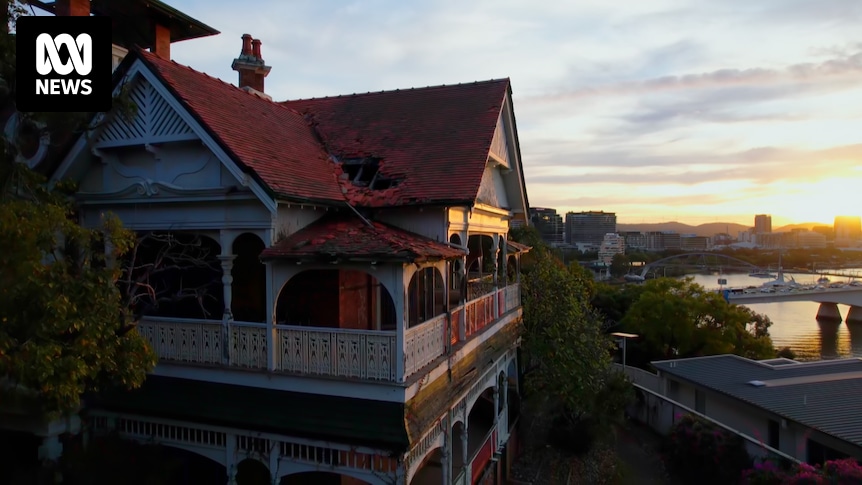[ad_1]
Perched atop the cliffs at Kangaroo Point on the edge of the Brisbane River is one of the most iconic houses in Brisbane.
Its original name, chosen by its architect, is ‘Home’ but many know it by the name of the family that lived in it for generations — Lamb House.
Now, close to three years after Queensland couple Steve and Jane Wilson bought the dilapidated riverside mansion, the bulk of its restoration is complete.
The mammoth task involved an army of people to both repair the federation-era house and restore it to its previous brilliance.
The Wilsons bought the house in 2021 for $12.75 million and planned to spend slightly more than that again, around $15 million, on the repairs and restoration.
Their goal was to return it to the vision that its architect, AB Wilson, had for it when it was built in 1902-3.
“Alexander Brown Wilson is his full name, he was very distinguished as an architect [and] revered for building distinguished homes,” Steve told ABC TV’s Restoration Australia.
Lamb House or Home wasn’t the first AB Wilson design the Wilsons restored; they’ve spent the last 30 years or so working on their 1888 house, Kinauld.
“We’ve been practising a long time for this project, but we’ve got our training wheels off now,” Jane said.
For many years before the Wilsons bought it, Lamb House sat empty and decaying after its previous owner, Joy Lamb, moved out in 2015 and failed to pay more than $300,000 in council rates.
Vandals and squatters had trashed and graffitied the house, and many of its historic features and fixtures were broken, damaged or stolen.
After the Wilsons bought the house they had to hire security to stop people from breaking in.
“When we first walked into the house it was a shocking mess, to be honest,” Jane said.
“There was an urgent need to understand whether we were safe actually walking through the house, whether the ceiling might collapse on us.”
Steve said the pair were saddened to see it in its former state but determined to return it to its original glory.
“It was just a sense of ‘Wow, how can anyone let such a grand old dame end up like this?'” he said.
“It’s an example of a house that was built for a successful family at the time in a very prominent position, and in some ways, it’s a symbol of the excitement of Brisbane.
“It’s [also] a home that many people in Brisbane adore and so there’s an extra responsibility, you’re doing it for a lot of other people as well.”
Plans and timeline
And so, after 18 months of repairs to make it safe again, the Wilsons set their sights on having the full restoration done in six months.
Because of the state of the house almost every millimetre needed attention of some kind — from the staircases to the bathrooms, the ceiling to the timber doors.
The plan was for most of it to re-emerge as it was originally designed, including the floor plan.
Two of the six bedrooms were repurposed as bathrooms and another existing bathroom was restored.
Upstairs, a study was planned for the attic space, while downstairs the kitchen would be brought into the 21st Century and a powder room created near the entrance.
But one of the most spectacular restorations was the grand lay light (stained glass skylight) in the entrance above the sweeping staircase.
“You’ll have these little shafts of colour which will change as the sun moves or as the clouds come over,” Steve said.
“It’s almost like … an aquarium of light in this wonderful room.
“We pinch ourselves every time we come here and we think, ‘What a project, what a spot, what a place’.”
Old-world trades in action
Before the actual restorative work could begin Jane, Steve and their crew of workers spent hours upon hours trying to replicate and research the damaged details of the house.
That included peering beneath layers of graffiti and dirt to work out the original colours and forensically looking through old photos to work out the types of designs and fixtures that were used.
The project also involved a call to arms for those skilled in old-world trades.
Gerry Cummins and Jill Stehn who specialise in stained glass restoration put their hands up to recreate the 2.2 metre by 1.8 metre lay light, composed of 1,000 pieces of glass.
“Stained glass, it does not forgive you. You cannot make a mistake. It’s so unrelentingly, unforgivingly perfect,” Gerry told ABC TV.
“The technique is obtuse and difficult and gives you heart attacks but at the same time the effects you can get through skill from your mind to your hand to the object is so deeply, deeply satisfying.”
It’s no surprise that after many hours of painstaking work, Jill described feeling “very satisfied” when it was done.
“I’d spent so long cutting the glass and doing the lead lighting, it felt like it was never going to end,” she says.
“When it did end and it looked so good I was rapt!” she laughed.
For Peter, a wood carver, the project was so enticing it lured him out of retirement.
“I think woodcarving’s a bit of a lost trade these days, like a lot of hand-taught trades,” he said.
“I’m happy to be part of the restoration of this house.
“It’s a good old heritage house that needs to be saved and it’s fortunate there’s people around that have got the finances to save these old places, otherwise they’d just crumble and be lost.”
Loading…
Another of the hand-taught trades in action on the restoration was plastering.
Heritage plasterer Scott McMillan recreated the ceiling roses for the light fittings, another period feature, and shaped the cornices in situ in a process known as “running the cornice”.
“The main objective here is to respect the original house’s fabric,” he said.
“Any reinstatement works that we’re carrying out throughout the house must be done using honoured techniques and methods.”
It wasn’t just historical trades that were needed though, modern techniques like acid drip and sand-blasting were used to restore the many cast-iron balustrades.
And the gardens were given a makeover, too.
“The gardens are just as important as the house,” Jane said.
“To set this gorgeous house off we really need to have the gardens planted up in a very thoughtful and representative way that respects the heritage of the house.”
‘Home’ once more
Six months came and went in a flash, but by early 2024 the restoration was all but complete.
The restored timber doors, revamped walls and ceilings, and the gloriously revived period details transformed the house from its dilapidated state to a piece of history in the present.
And the jewel in the crown — the lay light — cast its beautiful glow once again.
“It’s an absolute jewel box, this room [the entrance], isn’t it?” Steve remarked.
“So often those old Victorian houses, you walked in and they’re dark.”
Loading…
So what’s still to be done? Steve and Jane were waiting on bespoke fittings for their mater bathroom and the kitchen is set for a modern renovation sometime in the future.
There’s also work to be done on the master bedroom but, as Steve explained, they wanted to live in the house before they “start dressing it up”.
“We need to sleep here, we need to see where the sun comes up,” he said.
Time-wise their six-month estimate blew out to closer to three years, something the pair both concede was inevitable.
“It’s been two and three-quarter years … a fair bit of that is our doing because we kept wanting it to be better,” Steve said.
While they wouldn’t reveal exactly how much the project ended up costing, they indicated it was more than their initial budget but less than $20 million.
“It’s a meaningful sum of money,” Steve said.
“A lot of that is us choosing to do it better than perhaps we originally thought and just generally, the cost of construction has kept going up.”
The couple plan to open the house up for charity and other events and say they think AB Wilson would be “very pleased” to see how Home turned out.
“We’ve respected what was good about what he did,” Jane said.
“He was contemporary in his thinking and I think he would’ve enjoyed seeing [the] change.”
The new season of Restoration Australia, featuring Lamb House, airs tonight on ABC TV at 8pm or stream anytime on ABC iview.

